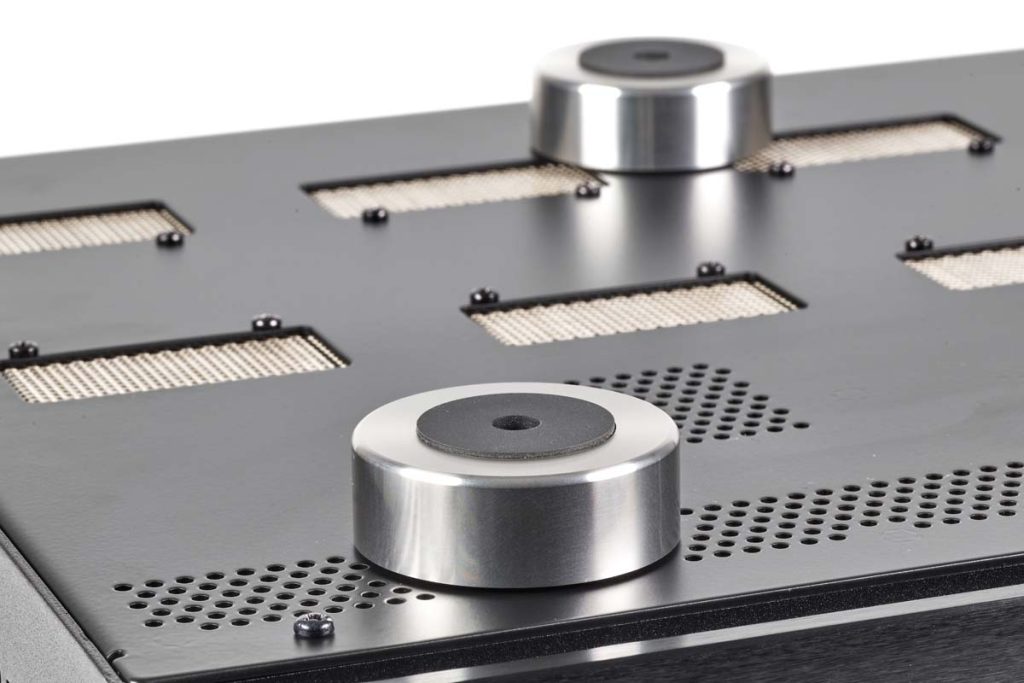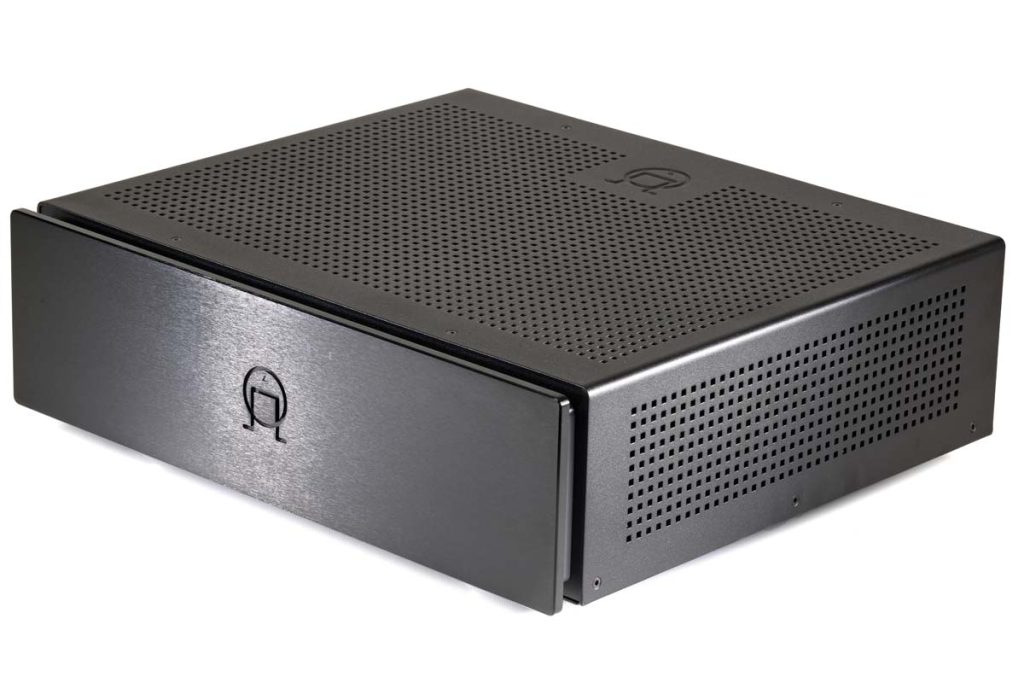What business does an eight-channel power amplifier have in our listening room? No worries, it’s still all about stereo. This black box allows you to configure your power output to your speakers pretty much any way you like. Let’s see if the math works out…
What kind of high-ender are you? There’s basically two types: Some simply want to integrate a few exquisite components into the living room without any fuss and then enjoy music without a care in the world. And then there are those who absolutely insist on tormenting themselves – pardon me, what I mean is, of course: Those who are driven by perfectionism and to whom their passion for high-quality music reproduction comes with the promise of an involving experience. Their love of music is joined by a constant itch for experimentation, an urge to always try something new in search of the next incremental improvement in sound. It’s all about the journey.
An audiophile geek owns a corner of my mind as well, and bi-amping is one of those experiments that have intrigued me for quite some time, but which I have consistently postponed for just as long in view of the expense, even though the advantage is obvious: At the same SPL, the signal amplitude in the bass is many times higher than in the treble – in this respect it makes absolute sense to keep the high and low frequency branches as separate as possible, so that the former can reach the tweeter unmolested by the latter. Still, buying an entire additional power amp just for this purpose always seemed kind of wasteful to me; I always had the impression that, given the same budget for a preamp and power amp combo, it’s wiser to invest the money in just two components rather than three.
Audiophile Math Problems
And this is exactly where the Primare A35.8 comes in, a bridgeable eight-channel power amplifier that makes me rethink my calculations from scratch: At around 5000 euros, its list price is only 1800 euros higher than that of its two-channel counterpart, the A35.2, so if I buy eight channels instead of two, I’ll only pay a good 600 euros for each of them instead of 1600 euros, my inner accountant rejoices. But as tempting as this numbers game is, the question naturally arises as to why on earth I should need eight channels to drive two speakers. The answer becomes apparent when looking at the connection panel, which reveals the remarkable flexibility of the power amplifier. Two of the eight pairs of speaker terminals can be bridged, which increases the already decent output of 150 watts at 8 ohms to a whopping 375 watts – at 4 ohms the values are doubled in each case. If you feed the high and low frequency branches of your speaker individually with a pair of bridged channels, all eight outputs actually have an occupation.
But, wait – there’s more. In bridged mode, the amplitudes of the two channels generally add up to twice the value, which effectively means a level increase of 6 decibels compared to two-channel mode, in which each pair of terminals operates conventionally on its own. For this reason, the Primare A35.8 has a three-way toggle switch on each channel pair that gives the user the choice not only of whether to bridge, but also how: In addition to the option to run the channels separately and the bridged mode with +6 dB, the third position of the toggle switch allows to combine two channels with no level increase. This opens up a whole range of possibilities. In a home theater setup, for example, one pair of power amplifiers could be used for each of the LCR speakers, leaving two individual power amplifiers for the rear channels. In a stereo configuration, the option to add two channels each without affecting the output level opens up even more exotic constellations: If you have a tri-amping capable speaker in the chain, you can hook up the tweeter and midrange to a single power amplifier each, while the power-hungry woofers are allowed to suck on two pairs of speaker terminals each, without changing anything in the tonal balance. And all of this can be done with just this one, matter-of-fact-looking scandinavian 43-centimeter box – pretty impressive.
However, I cannot conceal one not insignificant caveat in all these considerations: The Primare A35.8 offers all the mentioned possibilities per se without restriction, but the cabling can be quite tricky: For our test, in-akustik provided us with a pair of Y-XLR cables, which allows for a bi-amping configuration by connecting the left and right preamp outputs to two pairs of power amps each. However, things get complicated in the tri-amping scenario at the latest: Here, three-way adapters are needed, which would need to be made to order.
Sonic Baseline
Before we get down to the nitty-gritty, let’s first take a down-to-earth look at the Primare A35.8 in single-wiring mode. As a partner, I use the DALI Epicon 6. With its well-rounded tonal character and effortless verve, it has earned a spot as a kind of standard measure in our listening room. Right from the first bars it becomes clear that the Danes have some excellent chemistry going with the Swedish powerhouse. Dianne Reeves’ voice has exactly the right amount of body on “Old Country” (The Grand Encounter), the Scandinavian duo skilfully traces out the surface texture – the presentation seems enormously organic and natural. A muscular, textured bass foundation carries the action without ever really drawing attention to itself. The Primare maps out everything that’s going on in the bass with unflustered assertiveness and always impeccable control. Youn Sun Nah’s Tom Waits cover “Jockey Full Of Bourbon” (Voyage) also shows the impressive stage depth that the combo can throw into the listening room: Voice and double bass are placed about realistically close, while the bongos in the background are positioned way back.
Is More Actually More?
So with the bar set quite high already, I take out the cable bridges on the speaker terminals, connect a second pair of speaker cables and go right back to “Old Country”. When I first hear pretty much exactly the same as before, I’m not much surprised – I didn’t expect a night-and-day difference, besides, my acoustic memory is spoiled by Youn Sun Nah’s intermezzo. So back to single-wiring mode, and that’s when the differences start to show: even without the double feed it already sounds great, but driving the trable and bass branches separately brings about some subtle but decisive changes: With two pairs of channels bridged, the bass gains another ounce of impact and definition, but at the same time is even more permeable for the mids, which can now breathe even more freely. In addition, especially with the bowed bass at the beginning of the piece, it is noticeable how the attack and decay of the notes is traced even more finely. The stage does not change significantly in its extension, but the individual sound events now seem even better separated. A game changer? Not really, but after two or three changes I’m confident I could blindly tell the difference between single and bi-amping – by small, but clearly comprehensible differences, which in retrospect I no longer want to miss, because they simply provide the decisive bit more engagement when listening to music.
The experiment in search of the next bit of sound quality can therefore be considered absolutely successful – especially when you consider that the additional costs are very reasonable and the eight-channel power plant that is the Primare A35.8 does not take up more space in the rack than a stereo power amplifier.
Accompanying Equipment
CD-Player: Audio Note CD1.1x, Ayon CD-3sx | Network player/DAC: Cambridge Audio CXN V2, x-odos xo|stream pro | Preamplifier: AVM Streaming DAC SD6/8 | Integrated amplifier: Aavik I-580, Trigon Exxceed | Loudspeakers: DALI Epicon 6, DynamiKKs! Monitor 10 | Racks: Creaktiv, Solidsteel | Cables: in-akustik, AudioQuest, Furutech, Vertere
Eight-Channel Power Amplifier
Primare A35.8
Concept: Class D eight-channel power amplifier | Inputs: 8 x RCA, 8 x XLR | Outputs: 8 pairs of speaker binding posts, switchable: single, bridged, bridged +6 dB | Features: 2 x 3,5-mm-Trigger-Input/Output 12 V, RS232 interface | Finishes: Black, Titanium | Power per channel: 150 W (8 Ω), 300 W (4 Ω) | Power per two bridged channels: 375 W (8 Ω), 750 W (4 Ω) | Dimensions (W/H/D): 43/15/40 cm | Weight: 15 kg | Warranty period: 2 years | Price: around 5000 €
in-akustik GmbH & Co. KG
Untermatten 12–14
79282 Ballrechten-Dottingen
Phone: +49 7634 56100
www.in-akustik.de











